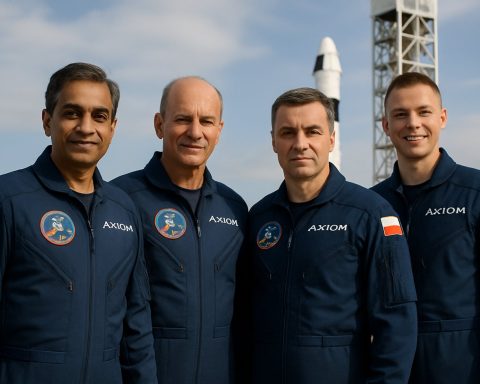- SpaceX and the U.S. National Reconnaissance Office (NRO) have launched mission NROL-145, focusing on advancing space intelligence.
- This mission represents the shift to “proliferated architecture,” deploying a constellation of smaller, agile satellites rather than a few large ones.
- These satellites provide enhanced global data coverage and faster intelligence delivery, meeting growing surveillance needs.
- The Falcon 9 rocket, known for its reusability, successfully completed its 12th mission, demonstrating robust reliability.
- Details of the payloads are confidential, with speculation suggesting advanced surveillance capabilities similar to customized Starlink satellites.
- Initiated last year, such launches mark a silent revolution, emphasizing that strength lies in numbers and redefining space intelligence.
High above our daily lives, a new cosmic curtain unfolds, woven quietly by the partnership of SpaceX and the U.S. National Reconnaissance Office (NRO). Today at the break of dawn, amidst the mist-shrouded stretches of California’s Vandenberg Space Force Base, a SpaceX Falcon 9 soared into the sky, carrying with it the future of intelligence gathering.
In the early light of day, the might of human engineering tore through the fog, symbolizing more than just a routine launch. This mission, designated NROL-145, represented the 10th stride in the NRO’s revolutionary approach—its “proliferated architecture”. Rather than crafting a small number of sophisticated and costly satellites, the NRO is betting on an expansive fleet of smaller, agile ones. By deploying a constellation, akin to an electronic constellation of stars, the groundwork is laid for a seamlessly connected, omnipresent surveillance network.
The drive behind employing a multitude of nimble satellites lies in their unparalleled ability to revisit areas frequently, painting a more comprehensive tapestry of global data. As NRO Director Chris Scolese extols the virtues of these orbiting sentinels, the advantages are clear: faster delivery of vital intelligence and broader coverage to meet the escalating needs of their clientele.
In a choreographed display, the Falcon 9’s first stage completed a flawless landing on a waiting drone ship, marking its 12th mission. This remarkable return adds another feather to SpaceX’s cap, showcasing the robust reliability and reusability of their technology.
But beyond the pyrotechnics of the successful landing, there lies an air of secrecy. As is often with reconnaissance efforts, the NRO shrouds its missions in confidentiality. The specifics of the payloads remain a mystery. Speculation, however, hints that these industrious satellites are kin to SpaceX’s Starlink models, albeit customized with advanced surveillance capabilities.
Initiated just a year prior, the “proliferated architecture” satellites have exclusively journeyed aboard Falcon 9 rockets from Vandenberg. Each launch represents a silent revolution in space intelligence, underscoring the concept that strength lies in numbers. Deploying such an extensive network allows the U.S. to gain unprecedented insight, warding off potential blind spots from their watchful gaze.
As SpaceX and the NRO chart the expanse beyond our skies, they are not merely launching rockets—they are redefining the landscape of surveillance, cementing a new norm in how information will be captured, processed, and utilized. Human ingenuity powers their ascent, on a mission to unveil new mysteries with a never-before-seen frequency, all while echoing in the stillness of the universe.
The Future of Space Surveillance: What the SpaceX and NRO Collaboration Could Mean for Intelligence Gathering
The Role of Proliferated Architectures in Modern Surveillance
The recent collaboration between SpaceX and the U.S. National Reconnaissance Office (NRO) marks a significant shift in intelligence gathering, emphasizing a “proliferated architecture” framework. This approach replaces traditional, large, costly satellites with a constellation of smaller, more agile units. Here’s why this model is revolutionary:
1. Increased Frequency of Data Collection: Smaller satellites can frequently revisit target areas, offering a dynamic and comprehensive picture of global situations. According to the NRO, this enhances the speed and accuracy of intelligence (NRO.gov).
2. Cost Efficiency and Redundancy: Deploying numerous small satellites is not only cost-effective but also enhances redundancy. If one satellite fails, others can cover its responsibilities, ensuring uninterrupted data flow.
3. Enhanced Global Coverage: With satellites spread out, the network can cover larger areas more effectively, reducing blind spots and improving situational awareness.
How-To Steps & Life Hacks for Understanding Satellite Deployments
Understanding satellite deployments and their impact on intelligence:
1. Research the Basics of Satellite Orbits: Learn about geostationary, medium, low earth orbits, and how they affect satellite coverage.
2. Follow SpaceX and NRO Announcements: Track upcoming launches and the technologies involved to understand how they influence global surveillance strategies.
3. Explore Open-Source Data: Engage with publicly available satellite data to see real-world applications of proliferated architectures.
Market Forecasts & Industry Trends
The space surveillance market is projected to witness significant growth, driven by increasing geopolitical tensions and advancements in satellite technology. According to Space Data Association, the global satellite industry may grow at a compound annual growth rate (CAGR) of 5.6% from 2023 to 2028.
Reviews & Comparisons
Comparing traditional satellite systems with the proliferated architecture approach:
– Traditional Systems: Larger, more expensive, and complex, often limited in number due to costs.
– Proliferated Architectures: Smaller, cost-effective, frequent updates, and more resilient to failures.
Current Limitations and Future Innovations
While the proliferated architecture offers many advantages, it is not without limitations:
– Deployment and Maintenance Costs: Initial costs for launch infrastructure and ongoing maintenance could be significant.
– Environmental Concerns: Increased numbers of satellites may contribute to space debris problems.
Recommendations for Readers
– Stay Informed: Regularly check industry news to understand how these technologies may impact privacy and global security dynamics.
– Focus on Sustainability: Advocate for space sustainability practices to minimize threats to the orbital environment.
Related Links
– SpaceX
– National Reconnaissance Office
Through their partnership, SpaceX and the NRO are paving the way for a new era in surveillance and intelligence gathering with far-reaching implications for security, privacy, and technological advancement.







